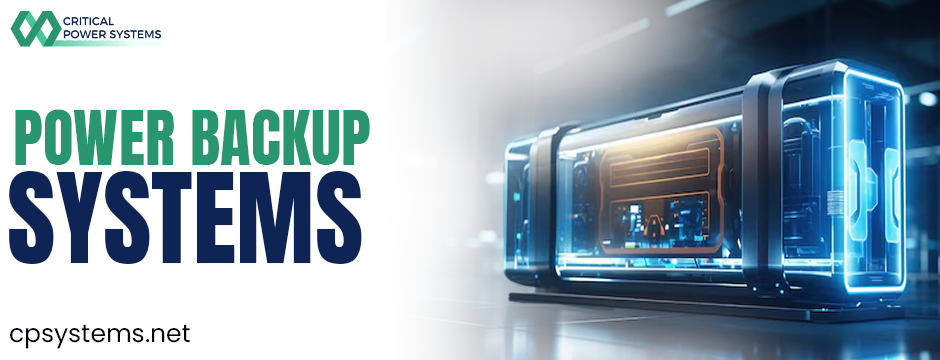There’s a big shift happening in how businesses think about power. It’s no longer just about having backup—it’s about knowing your backup is working, even before it’s needed. And with more companies relying on round-the-clock operations, cloud infrastructure, and remote access, that shift isn’t optional. It’s necessary. At Critical Power Systems, we’ve seen the evolution firsthand. What used to be a simple uninterruptible power supply (UPS) has now become an intelligent, connected guardian of uptime. The game-changer? IoT—the Internet of Things—bringing real-time monitoring, predictive analytics, and smart energy management right into your hands. Let’s dig into why smart UPS systems are no longer a luxury but a core part of your power backup systems strategy.

Power That Thinks for Itself
Back in the day, a UPS kicked in during an outage and… well, that was about it. It was reactive by nature. You didn’t think about it until something went wrong. But today’s businesses can’t afford that kind of uncertainty.
Smart UPS systems are different. They don’t just sit there waiting for a power cut. They’re busy working in the background—collecting data, checking voltage patterns, monitoring battery health, and flagging issues before you even know they exist.
These systems can actually tell you when a battery is nearing the end of its life. They can warn you if there’s a fluctuation in the power feed. And if you’re off-site? You can check on all of it from your phone.
That’s not just smart—that’s peace of mind.
The Role of IoT in Modern UPS Systems
So what does IoT really mean for UPS performance?
It’s about connectivity and control. IoT-equipped UPS units are designed to communicate—sharing real-time data with cloud platforms, sending notifications, integrating with dashboards, and even connecting with your broader project management system design setup.
With this level of visibility, you’re not guessing anymore. You’re making decisions based on clear, up-to-the-minute information.
Imagine knowing exactly how your backup systems are performing across multiple sites. No guesswork. No scrambling during a crisis. Just solid, reliable insight at your fingertips.
Predictive Maintenance: No More Surprises
One of the biggest advantages of smart UPS systems is their ability to predict problems before they happen.
Using trends in performance data—things like voltage dips, battery discharge cycles, and load fluctuations—the system can identify early signs of wear or potential failure. That means no more unexpected breakdowns, no last-minute rush to replace parts, and no lost time waiting for emergency support.
It’s like your UPS has its own early warning system.
And when your business depends on uptime—whether you’re in healthcare, manufacturing, finance, or IT—that kind of reliability is invaluable.
Managing Energy the Smarter Way
Energy efficiency might not be the first thing you associate with power backup systems, but it should be.
Smart UPS setups help cut down on wasted energy by identifying inefficient load usage, managing peak demand, and even integrating with renewable sources when available. They help you avoid unnecessary power drain and keep your energy costs in check—especially useful for larger facilities where even a small change can make a big impact.
With proper analytics and configuration, you can even schedule non-essential equipment to run during off-peak hours. That’s not just better for your utility bills—it’s also better for the planet.
One System, Multiple Sites—Remote Management in Action
Let’s say you manage power infrastructure for a company with offices or locations across the country. Before smart UPS systems, that meant keeping teams in each location or traveling frequently to check equipment.
Now? You can monitor all of it from a centralized dashboard.
You can receive alerts, adjust settings, reboot systems, or schedule tests—all without being physically on-site. And if you do need a technician, you’ll already know exactly what the problem is before they get there.
That kind of remote access is more than convenient—it’s essential for modern, scalable business operations.
How Smart UPS Supports Broader Project Goals
The truth is, smart UPS systems don’t just operate on their own—they fit into your wider infrastructure plan.
Many of our clients at Critical Power Systems work with us not just for backup, but to align power systems with their project management system design—tying in with HVAC, lighting, security, and data storage to create a more responsive and adaptive facility.
Because when your systems are connected, they can respond together. A power surge triggers alerts across your network. A battery nearing the end of its life gets flagged during a system-wide health check. You gain not just more reliability, but more efficiency across your operations.

Planning Ahead: Building for Growth
One of the things we love most about connected UPS systems is how flexible they are. You can start with a small unit in one location and scale up as needed. And because these systems are modular and software-driven, upgrades don’t require a complete overhaul.
As your operation grows, your power backup systems grow with you.
Whether you’re adding more servers, opening a new facility, or shifting part of your workforce to remote roles, your smart UPS can adapt and expand to meet those changing needs.
And when it’s time to revisit your infrastructure plan? We’re right there with you, helping align your power strategy with your next big move.
Final Thoughts: It’s Time to Rethink Power Backup
We’re long past the days when a backup generator and a basic UPS were enough.
Today’s businesses need systems that don’t just respond to outages—but anticipate them. That connect with your broader infrastructure. That give you insight, control, and confidence.
At Critical Power Systems, we’re proud to help businesses across industries shift toward smarter, more resilient power solutions. Whether you’re upgrading an existing setup or building a new one from scratch, we’re here to make sure your power backup systems are ready for whatever comes next.
Because in business, uptime isn’t just about power—it’s about progress.
FAQs:
- What is a smart UPS system?
A smart UPS system uses IoT technology to provide real-time monitoring, predictive maintenance alerts, and remote access to power backup performance.
- How does IoT improve power backup systems?
IoT enables UPS systems to collect data, detect issues early, optimize energy usage, and integrate with broader project management system designs.
- Can I monitor UPS systems remotely?
Yes, smart UPS systems offer remote access via cloud platforms or mobile apps, allowing you to manage multiple locations from a centralized dashboard.
- Are connected UPS systems suitable for small businesses?
Absolutely. Smart UPS solutions are scalable, making them ideal for both small offices and large enterprise operations with growing infrastructure needs.
- How do smart UPS systems reduce downtime?
By detecting power irregularities and battery issues in advance, smart UPS systems help prevent unexpected failures and maintain continuous uptime.

